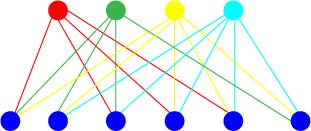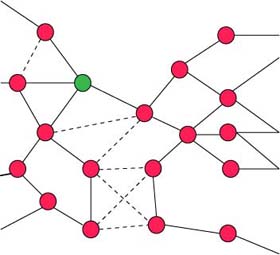Rhizomic Organization

A rhizomic wave.
Deleuze and Guattari (1980) wrote about Rhizomic organization, where the units are connected in reciprocal many-many relations, so that there are neither central units nor hierarchical structure in the complex. A rhizome means a system like that of a rhizomic plant, a mushroom or a crabgrass, for example. It is first and foremost a construction of lines connecting to each other, carrying their codes. They have no end, no beginning and no center, it expands in dimensions, growing from the middle, forming larger, denser and more complex networks. The various culmination points in rhizome, formed by the collision of expanding lines, are interconnected to any of the other points.
Example: Rosentiehl and Petitot on Wilf's friendship theorem. According to Wilf, if all the people of one town have one common friend, there's one person who is friend of everybody in the town. Now, Petitot and Rosentiehl have criticized this theorem of simply manifesting a problem of a hierarchic view to the plural units: the plurality should be understood by many-many relations.

A many-many-relation. I borrow this from Kincaid, who illustrates in similar manner the difficulty to explain totalities by particular units: the construction of a society by individuals, for example, can pass through many paths, so there are no single explaining units. This model is not a picture of a rhizome (particularly because the units on same level are not connected to each other), but a part of a rhizome could be illustrated in this way.

Rhizome. A proper rhizome, with many layers and connections.
Rhizome is an ontological theory that abandons both the ontic essences and the predetermined structures, such as the signifier-signified structure. But it is not only that: Deleuze and Guattari see everything being formed of rhizomes, so that there's no strict distinction between ontological and political and technical and semiotic. All layers of being are in first place rhizomic, and connected to each other in rhizomic manner. This is very similar to a P2P network. If we think of a rhizomic organization of a network, there are few aspects important to note, and that particularly lead us to non-structural view of a network.
-
interchangeability: any node in network can be connected to any other and so none of the nodes are irreplaceable. New connections can and will be made: even if some nodes are bridges to other components of the network, new connections can be made that create alternative routes to the other components.
- structuring: as new connections are made, there is no fixed structure, but an endless structuring of the network by the connections of nodes and disjunctions of the linkings, by transformation of the data and by movements of the data flows, as well as by connections to other networks – a new connection can unite the network to a whole new network. For illustration, check out the image above. There you can see, that the structuring is continuing and not fixed.
- building from the middle: a system should not be understood as being built from one or many of it's current ends to the others, but as being constantly built from the middle towards wherever it shall be connected. Thus it will be understood that the system is not closed. The linking continues and the changes in the lines connecting the nodes change the nodes and the structure of the network.

Suppose that only filled lines are actual. Now the green node is elemental, uniting otherwise separated entities. Interchangeability means, that new links can be established that do not pass by any specific node. Thus, the dashed lines demonstrate alternative connections that could be established in case that the green node would be eliminated.

Growth of a rhizome. A rhizome grows from the middle, defining the points it goes through on its way.
Obviously there's something in rhizome that the network model does not catch. A social network analysis doesn't analyze the non-social aspects, like the material ones, whereas a micropolitical research follows the lines of rhizome to any layers they are linked with, social or not. This is simply to be noted and as long as it is recognized and taken in count, it should be no objection to continuing with social network analysis in addition to micropolitical contemplation. The note is worth making, because connections to other layers and to other entities redefine the rhizome and add to its content.